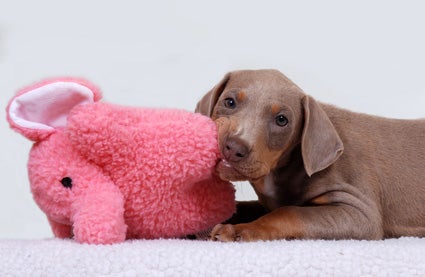Bite Inhibition 101: Teaching Your Puppy the Soft Mouth Method

If you have ever spent time playing with a puppy, you may have come away from the experience with more than just a few bite marks. Mouthing is one of the primary ways that puppies explore their world – they do not have hands, so they use their mouths to test new things. Puppies also bite as part of their method of play but they often do not realize that biting can hurt. If you want to teach your puppy to have a soft mouth, you will need to teach him bite inhibition.
What is Bite Inhibition?
One of the most important things you need to realize about your puppy’s biting behavior is that it is completely natural. In the same way that barking is a natural behavior for dogs, so is biting – you should not attempt to eradicate natural behaviors. What you can do, however, is teach your puppy that he has the ability to control the pressure of his bite and that he should do so when playing with other dogs or with people. Teaching your puppy bite inhibition is not necessarily about teaching him not to bite, it is about teaching him to have a soft mouth or to bite gently without inflicting pain or harm.
Tips for Teaching Your Puppy Bite Inhibition
In many cases, puppies learn bite inhibition simply by playing with their litter mates – if the puppy bites too hard, the other puppy will yelp and recoil. This teaches the puppy that he cannot bite too hard if he wants to continue playing. If your puppy doesn’t learn this on his own, you can use a similar strategy to teach him. The ultimate goal for bite inhibition training is to teach him that self-restraint is a desirable and a rewarded quality.
Follow these steps to teach your puppy bite inhibition:
- Play with your puppy as you normally would and wait for him to bite you.
- As soon as your puppy bites too hard, say “Ouch!” in a calm ton and gently take your finger or hand out of the puppy’s mouth.
- Wait a few seconds without paying any attention to your puppy, then resume normal play.
- Repeat this sequence as needed until your puppy starts to learn that biting too hard means the end of play time.
When following this training sequence, you may find that your puppy doesn’t get the hint right away. One thing you can try is to say “Ouch!” in a louder voice – it may startle your puppy into stopping what he is doing. If your puppy doesn’t get the hint when you stop playing with him for a few seconds, try moving to the other side of a baby gate or puppy playpen – your puppy can still see you and it will be obvious that you have withdrawn your attention. Once your puppy calms down, you can go back to the other side of the gate and resume play.
While working with your puppy using the soft mouth method you need to be very consistent – if you do not withdraw your attention each time your puppy bites too hard he won’t learn not to do it. You can help to reinforce your puppy’s soft mouth behavior by praising him when he bites but not hard enough to injure or harm. You can also reward your puppy for playing with his chew toys so he learns that it is okay to bite toys but not people.
Source: CKellyPhoto/Bigstock
Please consult the services of a Professional Dog Trainer, Behaviorist or Veterinarian before implementing any of the advice contained on this site.










 Your Privacy Choices
Your Privacy Choices